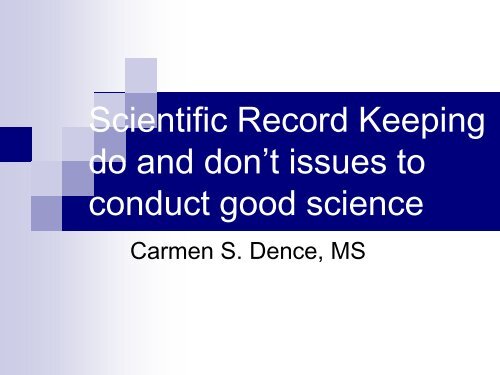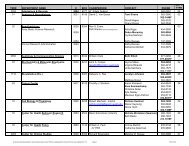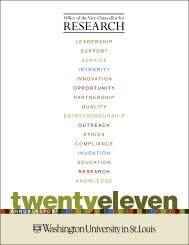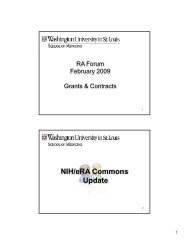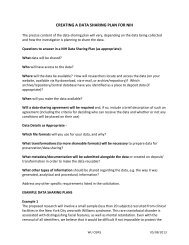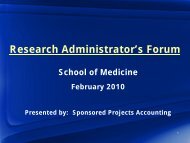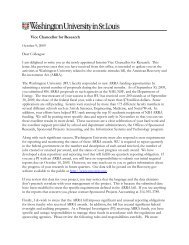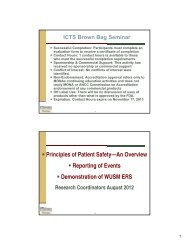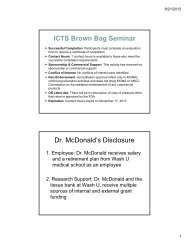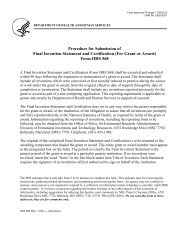Scientific Record Keeping do and don't issues to conduct good ...
Scientific Record Keeping do and don't issues to conduct good ...
Scientific Record Keeping do and don't issues to conduct good ...
Create successful ePaper yourself
Turn your PDF publications into a flip-book with our unique Google optimized e-Paper software.
<strong>Scientific</strong> <strong>Record</strong> <strong>Keeping</strong><br />
<strong>do</strong> <strong>and</strong> <strong>do</strong>n’t <strong>issues</strong> <strong>to</strong><br />
<strong>conduct</strong> <strong>good</strong> science<br />
Carmen S. Dence, MS
Good record keeping (GRK)<br />
promotes accountability <strong>and</strong><br />
integrity in research<br />
• GRK is necessary for data analysis,<br />
publication, collaboration, peer review<br />
among others.<br />
• GRK is necessary <strong>to</strong> support intellectual<br />
property claims.<br />
• Can defend you against false allegations<br />
of research mis<strong>conduct</strong>.
Continue…<br />
• GRK is important for the care of human<br />
subjects.<br />
• GRK is necessary for members of your<br />
group or any other researcher <strong>to</strong> be able <strong>to</strong><br />
duplicate your work, when needed.<br />
• GRK is required by NIH <strong>and</strong> other granting<br />
institutions <strong>to</strong> meet policies <strong>and</strong> st<strong>and</strong>ards<br />
for the <strong>conduct</strong> of <strong>good</strong> science
Data Authenticity <strong>and</strong> Integrity<br />
• Authentic data represent the true results of<br />
work <strong>and</strong> observations.<br />
• Carelessness, self-deception, deliberate<br />
misrepresentation will cause authenticity <strong>to</strong><br />
be lost .<br />
• Integrity is dependent on results being<br />
collected using well-chosen scientific<br />
methods carried out in the proper manner.
What is really a lab book?<br />
• Is a record of both physical <strong>and</strong> mental<br />
activity.<br />
• Good records are complete, accurate <strong>and</strong><br />
underst<strong>and</strong>able <strong>to</strong> others.<br />
• Each member of the research team is<br />
responsible for his/her records.<br />
• The PI has the final responsibility for the<br />
labora<strong>to</strong>ry records.
Labora<strong>to</strong>ry Notebooks<br />
• Who did it.<br />
• What you did.<br />
• When you did it.<br />
• What project the research was part of.<br />
• How you did it (metho<strong>do</strong>logy).<br />
• What materials were used.<br />
• Findings.<br />
• Your interpretation.<br />
• The next step.
Labora<strong>to</strong>ry Notebooks<br />
• Bound, serially numbered pages<br />
• All entries should be dated<br />
• Permanent ink<br />
• Table of contents- First few pages<br />
• Include the actual data, such as<br />
pho<strong>to</strong>graphs, negatives, au<strong>to</strong>radiograms<br />
<strong>and</strong> prin<strong>to</strong>uts
Data in Labora<strong>to</strong>ry Notebooks<br />
• Original data should be included.<br />
• Pho<strong>to</strong>graphs, negatives <strong>and</strong> similar can be<br />
glued or taped.<br />
• Other materials can be inserted in plastic<br />
sleeves (including CD or DVD).<br />
• Oversize material <strong>and</strong> magnetic media<br />
should be s<strong>to</strong>red, with the location <strong>and</strong><br />
coding scheme included in the lab book.
Electronic <strong>Record</strong> <strong>Keeping</strong><br />
• ELN – Electronic Labora<strong>to</strong>ry Notebook<br />
Database software<br />
Generic electronic notebooks<br />
<strong>Scientific</strong> electronic notebooks<br />
• CENSA – Collaborative Electronic<br />
Notebook Systems Association
The loose-leaf notebook<br />
• The use of a ring-binder <strong>and</strong> loose-leaf<br />
sheets in acceptable for many academic<br />
investiga<strong>to</strong>rs.<br />
Can be used as a supplement <strong>to</strong> bound NB<br />
Loose sheets should be dated <strong>and</strong> added <strong>to</strong><br />
the binder in chronological order, <strong>to</strong> meet<br />
st<strong>and</strong>ards of <strong>good</strong> science <strong>and</strong> assure<br />
research integrity.
Every lab book must include<br />
• Subject matter.<br />
• Experimental details.<br />
• Sketches, diagrams.<br />
• Control conditions.<br />
• Test results <strong>and</strong> their explanations.<br />
Conclusions should be short <strong>and</strong> supported<br />
by the factual data.
It is desirable <strong>to</strong> record…<br />
• Discussions with others (time, names,<br />
<strong>issues</strong>). Good for future credit.<br />
• Correspondence with colleagues (phone<br />
calls, e-mails).<br />
• Names of individuals who have played<br />
any role in your research. Technicians in<br />
core labora<strong>to</strong>ries are specially important
So…you made a mistake<br />
• They should be marked through with a<br />
single line <strong>and</strong> a full explanation of the<br />
error provided.<br />
• Never obliterate mistakes with ink or<br />
cover them with corrective fluid.<br />
• To a casual observer these actions may<br />
suggest improper reasons.
How long <strong>to</strong> keep<br />
notebooks?<br />
• NIH policy m<strong>and</strong>ates 3 years after the end<br />
of the project (grant funding period).<br />
• FDA policy m<strong>and</strong>ates 10 years after use.<br />
• Patent policy m<strong>and</strong>ates 23 years after<br />
issue of the patent.
How long <strong>to</strong> keep notebooks?<br />
• The organization with the longest policy<br />
has priority.<br />
• State law when present, usually overrides<br />
federal laws.
Who owns the notebooks <strong>and</strong><br />
data?<br />
• When NIH awards a research grant <strong>to</strong> a<br />
university, any <strong>and</strong> all data collected as<br />
part of that funded project are owned by<br />
the grantee institution.<br />
• Data books of all investiga<strong>to</strong>rs (PI,<br />
post<strong>do</strong>cs, grad students, technicians) are<br />
the property of the institution.
Who owns the notebooks <strong>and</strong><br />
data?<br />
• The principal investiga<strong>to</strong>r is the steward.<br />
• If the PI resigns or moves <strong>to</strong> another<br />
institution:<br />
Equipment <strong>and</strong> all data belong <strong>to</strong> the initial<br />
institution.<br />
Permission can be obtained <strong>to</strong> transfer the<br />
award, equipment <strong>and</strong> data.
Applicability<br />
• Data produced with Federal support that are cited<br />
publicly <strong>and</strong> officially.<br />
• Data collected by institutions of higher education,<br />
hospitals, <strong>and</strong> non-profit institutions<br />
Does not apply <strong>to</strong> commercial organizations.<br />
Does not apply <strong>to</strong> state <strong>and</strong> local governments<br />
• Applies <strong>to</strong> new <strong>and</strong> competing awards made after<br />
the effective date of the amendment (11/8/1999)
Research Data<br />
• <strong>Record</strong>ed, factual material commonly<br />
accepted in the scientific community as<br />
necessary <strong>to</strong> validate research findings.<br />
• Published<br />
Peer-reviewed scientific or technical journal.<br />
Cited by a Federal agency publicly <strong>and</strong><br />
officially.
Research Data Do Not Include:<br />
• Preliminary analyses<br />
• Drafts of papers<br />
• Plans for future research<br />
• Peer reviews<br />
• Physical objects (samples, tapes)<br />
• Trade secrets or commercial information
<strong>Record</strong> <strong>Keeping</strong> in<br />
Clinical Research<br />
Clinical data carries additional<br />
responsibility:<br />
• Patient privacy <strong>and</strong> confidentiality.<br />
• Civil <strong>and</strong> criminal penalties associated with<br />
violations of the Privacy Act.<br />
•The PI of the study has ultimate responsibility<br />
for all clinical research records.
Witnessing Data<br />
• Less common in the academic world.<br />
• A funding agency may require it for<br />
contract work such as clinical testing.<br />
• Bridging basic <strong>and</strong> applied research may<br />
require it.<br />
• Witnessing of data is necessary if the work<br />
may lead <strong>to</strong> a patentable discovery or<br />
invention.
Witnessing Data<br />
• The witness must be able <strong>to</strong> underst<strong>and</strong><br />
the work.<br />
• The witness must not be a co-inven<strong>to</strong>r.<br />
• Co-inven<strong>to</strong>rs are not allowed <strong>to</strong><br />
corroborate each other’s work.<br />
• Another worker in the same lab could sign,<br />
assuming he/she unders<strong>to</strong>od the work but<br />
was not involved with it.
Public Access <strong>to</strong> Data<br />
• The Office of Management <strong>and</strong> Budget<br />
(OMB) revised the regulations regarding<br />
public access <strong>to</strong> experimental data in 1999<br />
Circular A-110 included the revisions.<br />
The public can obtain access <strong>to</strong> experimental<br />
data through the Free<strong>do</strong>m of Information Act<br />
(FOIA).
FOIA Request Must Include:<br />
• Specific regulation or order citing the data<br />
• Publication cited<br />
• Grant number<br />
• Description of the data being sought<br />
• A statement that the data are being<br />
requested under the amendment <strong>to</strong><br />
Circular A-110
What happens if the PI refuses<br />
<strong>to</strong> comply with the request?<br />
• This would be viewed as a material failure<br />
<strong>to</strong> comply with the terms <strong>and</strong> conditions of<br />
the award.<br />
• NIH would initiate appropriate enforcement<br />
action.<br />
This could include withholding future support<br />
<strong>to</strong> the institution.
Best Practice Principles for<br />
Leaders of Research Groups<br />
• Set st<strong>and</strong>ards for record-keeping practices<br />
in their group.<br />
•Provide/assure training for group members<br />
•Emphasize the benefits of GRK <strong>and</strong> the<br />
problems with poor practices.<br />
•Provide examples of GRK practices.<br />
•Clarify data <strong>and</strong> research record ownership<br />
<strong>and</strong> access rights.
Best Practice Principles for<br />
Leaders of Research Groups<br />
• Perform periodic reviews of the<br />
records of members of your group.<br />
•Delegate, as needed, oversight <strong>and</strong><br />
training duties for group records <strong>to</strong><br />
senior members.<br />
•Provide the <strong>to</strong>ols for GRK.<br />
•Require adherence <strong>to</strong> GRK by group<br />
members.
Best Practice Principles for<br />
Leaders of Research Groups<br />
• Promote communication of research<br />
information within the group.<br />
•Have a plan <strong>to</strong> assure the transmission<br />
of important research information from<br />
departing group members.<br />
•Update records st<strong>and</strong>ards as needed.
Best Practice Principles for<br />
Department/School Level<br />
• “It is the policy of WU-STL <strong>to</strong> publish<br />
research results <strong>and</strong> <strong>to</strong> foster the use of<br />
University inventions, discoveries <strong>and</strong><br />
other works for the common <strong>good</strong>..” An<br />
18-page <strong>do</strong>cument is available:<br />
•Intellectual Property Policy:<br />
www.wustl.edu/policies/intelprop.html
With care <strong>and</strong> attention <strong>to</strong><br />
our work, we should avoid<br />
RETRACTION<br />
“We wish <strong>to</strong> retract our report (Science 2004;<br />
303, 371) in which we reported that β-Nacetylglucosamine-serine<br />
can be<br />
biosynthetically incorporated at a defined site in<br />
myoglobin in E. coli.
RETRACTION…<br />
Regrettably, through no fault of the authors,<br />
the lab notebooks are no longer available <strong>to</strong><br />
replicate the original experimental conditions,<br />
<strong>and</strong> we are unable <strong>to</strong> introduce this amino acid<br />
in<strong>to</strong> myoglobin with the information <strong>and</strong><br />
reagents currently in h<strong>and</strong>…”<br />
Z. Zhang eta l., UT at Austin.<br />
Science 2009; 326, 1187.
Sources of Information<br />
• Guidelines for <strong>Scientific</strong> <strong>Record</strong> <strong>Keeping</strong> in<br />
the Intramural Research Program at the<br />
NIH.<br />
• <strong>Scientific</strong> <strong>Record</strong> <strong>Keeping</strong>. Alan L. Goldin<br />
• Academic Research <strong>Record</strong>-keeping: Best<br />
Practices for Individuals, Group Leaders<br />
<strong>and</strong> Institutions. Academic Med. 2006;81,<br />
42-47.<br />
• <strong>Scientific</strong> <strong>Record</strong> <strong>Keeping</strong>. Francis L.<br />
Macrina. Chapter 11, pp231-256.
Additional Sources of Information<br />
• Responsible Conduct of Research<br />
Education Consortium (RCREC) Web Site<br />
• Office of Management & Budget Circular A-<br />
100 (section 36)<br />
• NIH Working Group Report on Research<br />
Tools<br />
• Kanare HM. 1985. Writing the Labora<strong>to</strong>ry<br />
Notebook, ACS, Washing<strong>to</strong>n, D.C.


